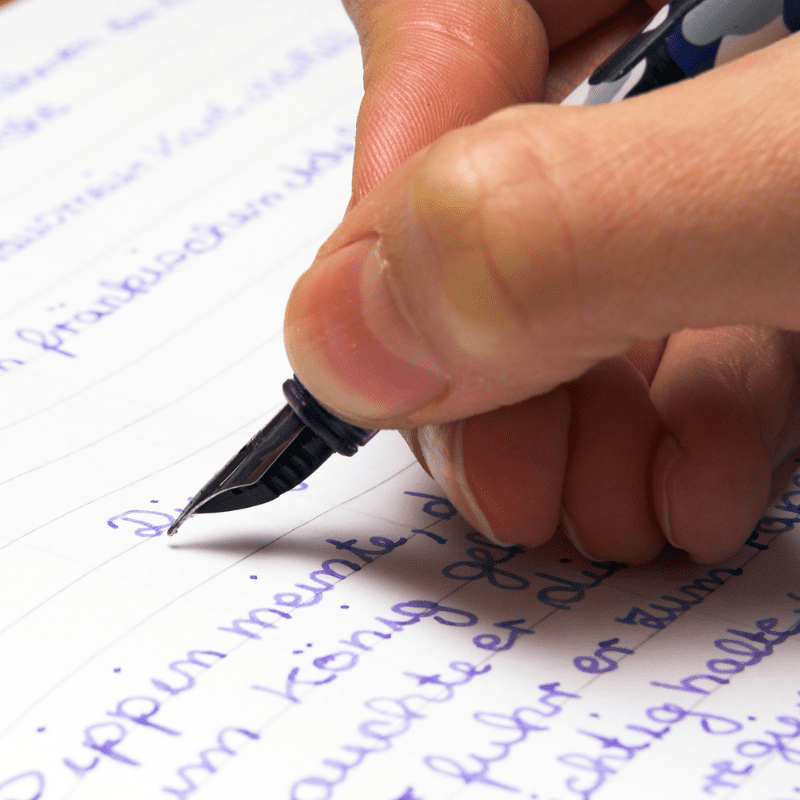Last Updated on May 10, 2022 by Jen
With notebooks, planners, and journals, there is a lot of handwriting. But in today’s world, we tend to do more typing than physical writing and our handwriting can get kind of sloppy. If you want others to be able to read your handwriting and have it look aesthetically pleasing, you want to improve your handwriting. You can do this in a few ways. Here are some tips on how to improve your handwriting.
1. The Pen Matters
Most of us don’t give much thought to the type of pen we use – as long as it writes well, that’s all that matters, right? But believe it or not, the type of pen you use can actually have an influence on your handwriting.
For instance, a ballpoint pen is going to produce a different result than a fountain pen. And if you’re someone who takes pride in their penmanship, making sure you’re using the right type of pen is important.
So, what’s the difference? Well, a ballpoint pen tends to produce neater, more consistent handwriting than a fountain pen. Fountain pens, on the other hand, tend to be a bit more expressive – your handwriting will likely vary more in terms of thickness and slant.
Therefore, if you’re looking for neat and tidy handwriting, especially while you are working on improving your handwriting, go for a ballpoint pen.
But if you want something with a bit more personality, go for a fountain pen.
2. Make Sure You’re Holding the Pen Correctly
Have you ever given thought to how you hold your pen? It might seem like a minor detail, but the way you hold the pen can actually have a big impact on your handwriting.
For example, if you hold the pen too tightly, your handwriting may appear cramped and uncomfortable to read.
On the other hand, if you hold the pen too loosely, your letters may be sloppy and difficult to decipher.
The best way to find a happy medium is to experiment with different grip styles until you find one that feels comfortable and produces legible results for you.
So next time you sit down to write, take a moment to consider how you’re holding your pen—it could make all the difference in the quality of your handwriting.
3. Use Cursive Instead of Print
Penmanship is a Lost Art. In the world of keyboards and autocorrect, fewer and fewer people are taking the time to develop their handwriting skills.
And while some may argue that print is just as good as cursive, the fact is that there are certain benefits to writing in cursive.
For one thing, it can help you to write more quickly. When you write in print, each letter is formed separately, which can slow you down and look childish. But with cursive, letters are joined together, so your hand can flow more smoothly across the page and create a more eloquent-looking result.
In addition, research has shown that writing in cursive can improve memory and focus. One study found that students who wrote in cursive had better recall of material than those who wrote in print. This could help boost your writing skills too.
Therefore, if you’re looking to improve your penmanship, you may want to consider giving cursive a try.
4. Write Larger
Many people believe that writing in a smaller size will help to improve their handwriting. However, this is not the case. In fact, write larger when you are trying to improve your handwriting.
The reason for this is that it is easier to control the movement of your hand when you write in a larger size.
When you write in a smaller size, your hand has to move more quickly, and this can lead to shaky and unclear letters.
5. Don’t Forget about Spacing
A big part of handwriting is spacing – making sure that your letters are evenly spaced apart. This may seem like a small detail, but it can make a big difference in the overall appearance of your handwriting.
Good spacing makes your writing more legible and creates a neater overall look.
The best spacing for handwriting varies depending on the size of the letters, but a good rule of thumb is to leave about half a centimeter between each letter. By spacing your letters correctly, you will instantly improve the legibility and appearance of your writing.
Practice to see what works best for you.
6. Use a Handwriting Guide
Many people believe that their handwriting is a fixed trait that cannot be changed. However, with a little effort, anyone can improve their handwriting.
One simple way to start making changes is to use a handwriting guide. These guides provide step-by-step instructions for how to form each letter of the alphabet.
As you practice following the guide, you will slowly start to see improvements in your handwriting.
In addition, you may also want to experiment with different pen and paper styles to find what works best for you. With a little bit of practice, you can have the neat and legible handwriting that you’ve always wanted.
7. Take Breaks and Stretch
Taking regular breaks from handwriting and giving your fingers and hands a stretch can actually be beneficial. This allows your muscles a chance to rest and recover, which can help reduce strain and improve dexterity.
Additionally, taking breaks allows you to reflect on your progress and identify areas that need improvement. As a result, you’ll be able to focus your efforts more effectively and see greater results.
in other words, if you’re looking to improve your handwriting, don’t be afraid to take a break every now and then!
8. Practice, Practice, Practice!
This one is obvious, but it needs to be said if you want to improve your handwriting.
Handwriting is a skill, and all skills need practice in order to improve.
Schedule time each day to work on your handwriting skills. You can schedule tasks, such as ‘use handwriting guide’ or ‘practice lettering’ or ‘play with different sizes of letters’, and then stick to that writing task to improve whatever skill you are trying to improve.





